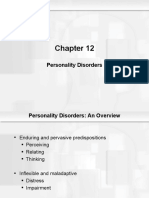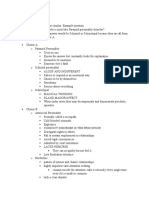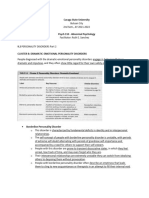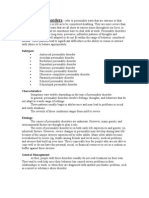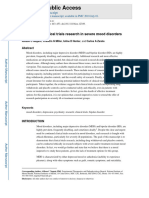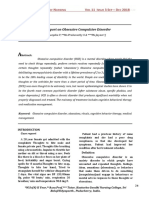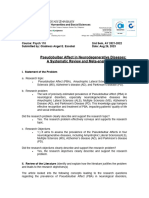0% found this document useful (0 votes)
109 views5 pagesChapter 13
1. Components of personality refer to how individuals interact with others, while personality disorders are mental disorders that impact thinking, feeling and behavior. Personality disorders may occur with other illnesses.
2. The three clusters of personality disorders are odd, dramatic, and anxious personalities. Odd personalities fear close relationships, while dramatic personalities fear social situations.
3. Odd personalities include paranoid, schizoid and schizotypal disorders and are characterized by eccentric behavior. Dramatic personalities, which include antisocial, borderline, histrionic and narcissistic disorders, make relationships almost impossible.
Uploaded by
pairednursingCopyright
© © All Rights Reserved
We take content rights seriously. If you suspect this is your content, claim it here.
Available Formats
Download as DOCX, PDF, TXT or read online on Scribd
0% found this document useful (0 votes)
109 views5 pagesChapter 13
1. Components of personality refer to how individuals interact with others, while personality disorders are mental disorders that impact thinking, feeling and behavior. Personality disorders may occur with other illnesses.
2. The three clusters of personality disorders are odd, dramatic, and anxious personalities. Odd personalities fear close relationships, while dramatic personalities fear social situations.
3. Odd personalities include paranoid, schizoid and schizotypal disorders and are characterized by eccentric behavior. Dramatic personalities, which include antisocial, borderline, histrionic and narcissistic disorders, make relationships almost impossible.
Uploaded by
pairednursingCopyright
© © All Rights Reserved
We take content rights seriously. If you suspect this is your content, claim it here.
Available Formats
Download as DOCX, PDF, TXT or read online on Scribd
/ 5































